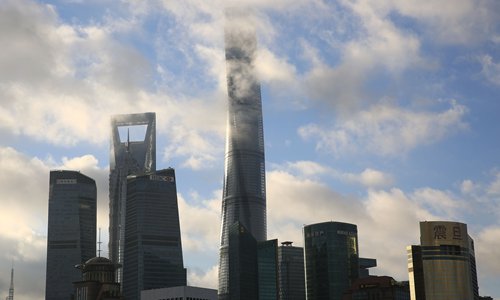HOME >> BUSINESS
China's inland cities grow robustly in H1, while coastal metropolises are slowing down
By Xie Jun Source:Global Times Published: 2019/8/4 20:58:39
Coastal metropolises including Shanghai, Tianjin are slowing down

A view of Shanghai on Thursday Photo: VCG
Though the China-US trade war weighs on the nation's economy, some Chinese cities have reported robust first-half GDP growth, of which many are inland cities whose economies have been boosted by booming trade with emerging markets and rising investment.
Some of the other strong performers included coastal cities whose trade has long focused on the traditional US market.
"It surprises me that cities like Shenzhen, which have been affected to a relatively large extent by the trade war, still achieved striking GDP growth in the first half of this year. This also shows the vigor of the private economy in those regions," Tian Yun, vice director of the Beijing Economic Operation Association, told the Global Times.
Among the cities whose GDPs surpassed 1 trillion yuan ($144 billion) in 2018, two inland cities - Chengdu, capital of Southwest China's Sichuan Province and Changsha, capital of Central China's Hunan Province - led GDP growth in the first half of this year, with both reporting expansion of 8.2 percent.
In Chengdu, the figure was unchanged from a year earlier, while Changsha's growth quickened from 6.36 percent recorded for the first six months of 2018.
Not far behind was Wuhan, an inland city that's capital of Central China's Hubei Province. Wuhan achieved GDP growth of 8.1 percent in the first six months.
China achieved 6.3 percent GDP growth in the first six months of this year, data from the National Bureau of Statistics showed.
Trade moves inland
Some of the inland cities' economic acceleration has been supported by rising trade, statistics showed. For example, Changsha's trade surged by 56.9 percent year-on-year to more than 83 billion yuan in the first half of this year, with exports rising by 79.6 percent, data from the Changsha Municipal Bureau of Statistics showed.
Another inland city, Southwest China's Chongqing Municipality, said trade rose 16.5 percent year-on-year to more than 266 billion yuan in the first half of this year, with exports up 16.5 percent. The figures were released by the city's statistical bureau.
Ye Hang, an economics professor at the College of Economics at Zhejiang University, told the Global Times on Sunday that inland regions rely more on exports of resources, which are less affected by external trade friction.
Tian also said that unlike coastal regions whose trade has focused on the traditional US markets, inland cities often focus more on trade with new destinations such as those along the Belt and Road Initiative and in Southeast Asia, which took off fast in recent years.
However, Tian said that he was impressed by the economic growth of some coastal regions that reported robust GDP growth despite the trade dispute with the US.
"In particular, Shenzhen's eye-catching GDP growth surprised me," Tian said. Shenzhen achieved GDP growth of 7.4 percent in the first half of this year.
According to Tian, this outcome reflects the local government's efforts to protect companies from trade pressure by such steps as discouraging banks from cutting back on loans. It also has to do with the vigor of the private economy in the city, with companies like Huawei reporting strong business growth.
Inland cities have also been supported by fast-growing infrastructure investment, experts pointed out. For example, Wuhan saw 10.9 percent fixed-asset investment growth in the first half of this year, beating the 5.8 percent average national growth of fixed-asset investment in the period.
Coastal cities adjust
In comparison with the rapid economic development of inland cities, some coastal cities seemed to slow down in their economic development.
For instance, Shanghai achieved growth of only 5.9 percent in the first half of 2019, down from 6.9 percent growth a year earlier.
"Many coastal cities are entering a period of industrial adjustment, shifting from dependence on infrastructure investment to innovation and research. The cost of such a shift is slowing GDP growth, but that's an inevitable trend and there will be a long-term payback," Ye said.
Tian said that the competition is growing hotter when it comes to technological upgrades and the governments of some inland cities are also encouraging innovation to catch up with the technological development in first-tier coastal cities.
"China's regional competition will only grow more intense in the future, with capital and resources to further tilt toward regions, whether inland or coastal, that provide a good environment. China's economy will be propelled and benefit as a result," he said.
Newspaper headline: Inland cities grow robustly in H1